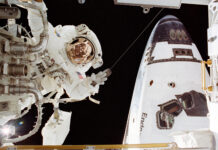Exploring the Curiosity Rover’s Recent Discoveries on Mars
The Martian landscape has always intrigued scientists and space enthusiasts alike, and NASA’s Curiosity rover continues to provide new insights into the Red Planet. Recently, the rover has been busy examining intriguing geological formations and collecting data that may reveal more about Mars’ past. In this post, we’ll delve into Curiosity’s recent activities during Sols 4348-4349 and explore what makes these findings significant.
Unveiling Mars’ Mysteries: A Close-Up Look
NASA’s Curiosity rover has been instrumental in exploring Mars since its landing in 2012. One of its key tools is the Mars Hand Lens Imager (MAHLI), a camera situated on the rover’s robotic arm. This powerful instrument allows scientists to capture detailed images of Martian rocks and soil. On October 27, 2024, during Sol 4346, Curiosity used MAHLI to create a composite image of a fascinating terrain. This image shows a textured surface resembling whipped chunky peanut butter, highlighting the unique geological features found on Mars.
The MAHLI camera employs a technique called "focus merging." This process involves taking multiple images of the same target at different focus positions and then combining them to create a single, sharp image. This method enables scientists to examine the intricate details of the Martian surface.
Planning and Preparation: A Day in the Life of Curiosity
Before commencing daily operations, the Curiosity team reviews the rover’s most recent navigation camera (Navcam) images to determine its exact location. This step is crucial as it helps the team plan the day’s activities. While the expansive Martian landscape can be captivating, the team focuses on nearby features that can offer valuable scientific data.
During the planning phase, scientists prioritize smaller geological features and decide which rocks are within reach of the rover’s instruments. For Sols 4348-4349, the team planned to investigate a coating of material exhibiting a deep-purple hue in some images. This peculiar coating became the primary focus of their close-up contact science.
Curiosity’s instruments, including the Dust Removal Tool (DRT) and the Alpha Particle X-ray Spectrometer (APXS), were employed to analyze a target named "Reds Meadow." The MAHLI camera captured detailed photographs of this target, aiding in the study of its composition.
Additionally, the ChemCam (Chemistry and Camera Complex) instrument was used to examine another target called "Midge Lake" through laser-induced breakdown spectroscopy (LIBS). This technique involves firing a laser at a target to vaporize a small portion, which is then analyzed to determine its composition. A passive ChemCam target named "Primrose Lake" was also documented to provide a comprehensive view of the coating using various instruments.
Documenting the Martian Landscape
Curiosity’s Mastcam, a camera system designed to capture high-resolution images, played a vital role in documenting the Martian landscape. It captured a mosaic of "Pinnacle Ridge," an area previously observed by the rover, but from a new perspective. This mosaic helps scientists study the sedimentary structures and understand the geological history of the region.
The Mastcam also documented the ChemCam LIBS target "Midge Lake" and created a mosaic of nearby rocks known as "Peep Sight Peak." This mosaic offers insights into the sedimentary structures in the vicinity. Furthermore, ChemCam conducted two long-distance Remote Micro-Imager (RMI) mosaics to analyze the stratigraphy of two structures, "Texoli Butte" and the "Gediz Vallis Channel," which Curiosity is currently navigating between.
Traversing the Martian Terrain
On the second day of the plan, Curiosity embarked on a 20-meter (approximately 66 feet) drive. This movement allowed the rover to explore new terrain and conduct environmental monitoring activities. One of the highlights of this day was an AEGIS (Autonomous Exploration for Gathering Increased Science) activity. AEGIS is an artificial intelligence system that enables Curiosity to autonomously select and analyze targets using the ChemCam LIBS instrument. This capability enhances the rover’s ability to gather valuable data efficiently.
The Significance of Curiosity’s Discoveries
Curiosity’s recent activities are part of a broader mission to uncover Mars’ secrets. By studying the planet’s geology, scientists aim to piece together its history and assess its potential for past life. The data collected by Curiosity contributes to our understanding of Mars’ climate, geology, and habitability.
One of the primary goals of the Curiosity mission is to explore Gale Crater, the rover’s landing site. Gale Crater is believed to have once contained a lake, making it a prime location for studying the planet’s ancient environment. By examining the sedimentary layers in the crater, scientists hope to reconstruct the planet’s past climate and assess whether conditions were conducive to life.
The Role of Technology in Mars Exploration
Curiosity’s success is a testament to the power of advanced technology in space exploration. The rover is equipped with a suite of scientific instruments designed to analyze the Martian environment. These instruments work together to provide a comprehensive view of the planet’s geology, atmosphere, and potential for life.
Key instruments on Curiosity include:
- MAHLI: A camera that captures high-resolution images of rocks and soil.
- ChemCam: A laser-induced breakdown spectrometer that analyzes the composition of targets.
- APXS: An instrument that determines the elemental composition of rocks and soil.
- Mastcam: A camera system that captures panoramic images and mosaics.
These instruments, along with others, enable Curiosity to conduct a wide range of scientific investigations, from analyzing rock samples to studying the planet’s weather patterns.
Reflections on Mars Exploration
The Curiosity rover has been a remarkable success, providing valuable data and insights into Mars’ past. Its findings have expanded our understanding of the Red Planet and paved the way for future missions. As we continue to explore Mars, each discovery brings us closer to answering fundamental questions about the planet’s history and potential for life.
The mission’s success underscores the importance of international collaboration in space exploration. Scientists and engineers from around the world have contributed to Curiosity’s development and ongoing operations. This collaborative effort highlights the shared goal of advancing our knowledge of the universe.
Looking Ahead: The Future of Mars Exploration
NASA’s Mars exploration program is set to continue with future missions aimed at further unraveling the mysteries of the Red Planet. The Mars Sample Return mission, for example, aims to bring back samples collected by the Perseverance rover, Curiosity’s successor.
These missions are part of a broader strategy to lay the groundwork for human exploration of Mars. By studying the planet’s geology, climate, and resources, scientists are preparing for the day when humans will set foot on Mars.
In conclusion, Curiosity’s recent activities during Sols 4348-4349 exemplify the rover’s ongoing contributions to our understanding of Mars. Through detailed analysis and advanced technology, Curiosity continues to unlock the secrets of the Red Planet, offering valuable insights into its past and potential for life.
For more information about Curiosity’s mission and latest updates, visit the official NASA website at NASA’s Mars Science Laboratory.
For more Information, Refer to this article.



































